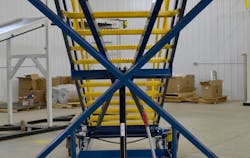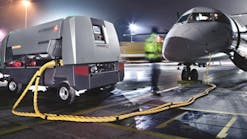Movement is a beautiful thing. Airport personnel lift, shift and maneuver countless pieces of cargo and luggage daily to keep packages and people moving from point A to point B. But the process isn’t flawless. With so much movement, there’s ample chance for equipment damage or bodily injury.
Day after day, airport personnel expose their hands and fingers to pinch points, and put their backs through lots of twisting, lifting and straining. On top of that, equipment can fail, break away and become a hazard to employees or aircraft.
In other words, accidents can happen.
This is what makes prevention so important. Most companies have stringent safety rules and guidelines that go above and beyond what’s mandated. They know they’re liable and they care about their employees, so they adopt specific requirements to protect employees and others, as well as their reputations. These safety guidelines slightly differ from company to company, based on differences in operations.
After more than 35 years of working with ground support equipment and the people who use it on a daily basis, we’ve identified three of the most common causes of injury in ground operations: overall ergonomics, misuse of equipment and lack of maintenance.
Let’s break these down for a better idea of what to look for to prevent injuries and damage on the tarmac.
ERGONOMICS
Ramp agents lift and twist all day while loading and unloading baggage, luggage or freight. This is why transfer points and heights have become an industry focus. Equipment manufacturers hone in on target heights and dimensions, aiming for heights of about 21-24 inches (53-61 centimeters) so the majority of operators can keep their backs straight when lifting and transferring to and from conveyors or baggage handling systems.
Even little tweaks, down to the rollers or casters, help ground support crews transfer materials more easily. For example, if a company can only perform side load transfers, rollers might be best because it’s easier to move heavy loads over rollers. But rollers limit movement. Once a container is on the dolly, it is limited to simply forward and backward motion. Casters, on the other hand, are multidirectional, so operators can rotate containers in any direction once it is loaded, relieving stress placed on the operators, accommodating applications where that is required.
Beyond the movement of cargo, the International Air Transport Association, known as IATA, carefully spells out restrictions on sharp edges and pinch points. The association requires no more than a 1/4-inch gaps between belted conveyors, pulleys and rollers to protect hands and fingers from injury.
Attention to detail on the most accessed parts, such as towbars, can impact the safety of employees. Additionally, towbars can feature a toe guard and a towbar hold-up option. Toe guards help protect an employee’s foot if the bar drops, they also keep the lunette towing eye from becoming degraded from dragging on the ground.
The towbar hold-up has become increasingly common in the past five years with many companies standardizing the design. The spring-loaded towbars hold the entire towbar off the ground when it is dropped. This ensures optimal safety for ground support personnel while also eliminating potential towbar damage.
EQUIPMENT MISUSE
Airlines commonly require extensive equipment manuals, including operators’ manuals, training manuals, and train-the-trainer documentation. Despite having a wealth of training materials from manufacturers on product maintenance, pinch points, transfer areas and capacities, it’s not unusual for personnel to miss, or misunderstand, portions of the training. This can lead to painful mistakes.
Manufacturers should visit sites to see how an operation works before designing new equipment, ensuring the best equipment for the particular operation. These manufacturers know that it’s good to check in on a company’s maintenance routines and facilities, to see the equipment at work in their environment and identify weak points to improve.
For example, ground support personnel may be positioning a ULD in a less than ideal formation or transporting a dolly or other piece of ground support equipment with a forklift in a way that will eventually damage the equipment. Small modifications or slight re-engineering could boost the efficiency and safety of personnel using the equipment in an adapted way. Manufacturer representatives who are willing to spend quality time on site to examine the process will recognize the misuse. That person can then make suggestions for how to enhance a product specific to that operation, update a proposal drawing for the engineers to go over, and devise a service bulletin.
Even simple things, such as adding a bolt, protector plate or tineways (forklift pockets), will boost the unit’s longevity and reduce repairs. This is why it’s important to find a manufacturer that offers customization and is able to quickly deliver special requests.
One of the most common types of equipment misuse is overloading. Overloading a baggage cart, for example, can increase the risk of the unit rolling over and possibly causing injury. A unit’s capacity needs to be labeled properly and employees need training stressing the importance of never carrying more than the unit specifies.
Pushing the limits of equipment on an airport or cargo ramp is not a good idea. In the same regard, upkeep of the product cannot be ignored, either.
LACK OF MAINTENANCE
We’ve all squeezed out a few extra miles on our car before getting an oil change. Maybe we don’t check tires as often as we should and, for the most part, we probably don’t keep close tabs on our fluid levels. Despite all that, things seem to generally work OK.
Don’t build off the lesson your car might give. You can only go so far before damage sets in. And, in a cargo ramp or airport setting, the chance of someone getting hurt increases. Consider what can go wrong with ground support equipment: brakes can be out of adjustment, towing eyes can wear, springs can stretch, rust can form. Now, consider the impact of those problems.
Many places do a maintenance once-over each year. That’s not enough. What’s worse, many only service equipment once it has been red-tagged and is completely out of service. When an operation uses the equipment to that point, there is more chance for failure that could result in expensive damage or dramatic injury.
Some manufacturers build their products with a longer intended lifecycle. They use high-grade components and thicker steel, and they test the products intensely to identify any weak points. While this kind of manufacturing greatly helps to avoid premature failure, routine maintenance should still be still a priority.
Manufacturer manuals contain information on maintenance requirements, which should be followed routinely rather than read only once equipment breaks down.
PREVENTION
Human error exists in any industry. IATA and equipment manufacturers do what they can to make equipment and processes as foolproof as possible to overcome the element of human error. For example, IATA requires equipment labels to indicate the capacity and dangers, such as pinch points or areas on ramp equipment not intended for walking, to ensure safety.
Some companies take it further, specifying equipment to be manufactured with more visual reminders, such as manually engaged locking mechanisms on vertical restraints so operators have a reminder of a task they need to perform.
Yet other companies prefer to have GSE manufacturers use a more automated design. So, in the same example as above, the manufacturer would use spring-activated locking mechanisms to avoid an operator needing to remember to engage the mechanism. There’s no right or wrong, necessarily, but rather finding a product that suits specific needs, situations and employees.
Paint and warning decals are another way manufacturers can indicate dangers or reminders. A safety yellow or red applied on certain warning areas (towbars, hitches, pallet stops) is a great visual aid to remind people of stored energy, large springs, or potential for injury if not used cautiously or properly.
There is clearly a lot of room for error surrounding ground support equipment. However, with attention to detail, careful training and a focus on preventative maintenance, a lot of equipment damage or injury to personnel can be reduced, if not eliminated. Time and attention is a small price to pay for safety on the tarmac.
About the Author: John Hoeper is the vice president of engineering for WASP Inc. He has more than 27 years of experience in ground support equipment design and manufacturing.





